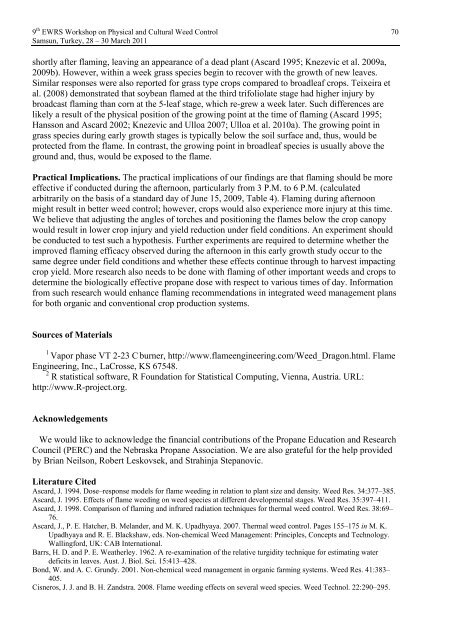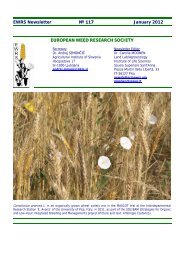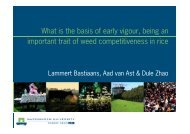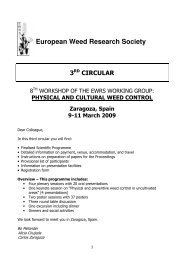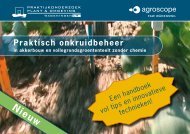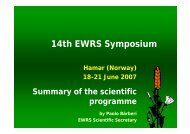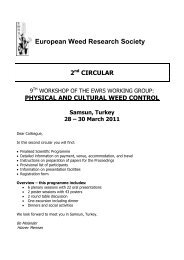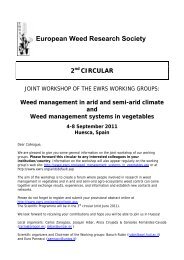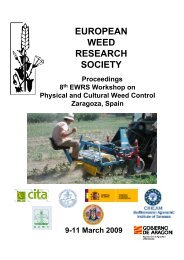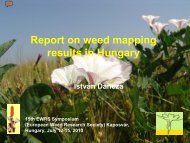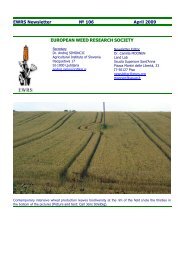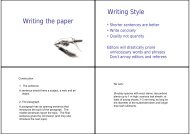Physical and Cultural Weed Control Working Group of - European ...
Physical and Cultural Weed Control Working Group of - European ...
Physical and Cultural Weed Control Working Group of - European ...
Create successful ePaper yourself
Turn your PDF publications into a flip-book with our unique Google optimized e-Paper software.
9 th EWRS Workshop on <strong>Physical</strong> <strong>and</strong> <strong>Cultural</strong> <strong>Weed</strong> <strong>Control</strong> 70<br />
Samsun, Turkey, 28 – 30 March 2011<br />
shortly after flaming, leaving an appearance <strong>of</strong> a dead plant (Ascard 1995; Knezevic et al. 2009a,<br />
2009b). However, within a week grass species begin to recover with the growth <strong>of</strong> new leaves.<br />
Similar responses were also reported for grass type crops compared to broadleaf crops. Teixeira et<br />
al. (2008) demonstrated that soybean flamed at the third trifoliolate stage had higher injury by<br />
broadcast flaming than corn at the 5-leaf stage, which re-grew a week later. Such differences are<br />
likely a result <strong>of</strong> the physical position <strong>of</strong> the growing point at the time <strong>of</strong> flaming (Ascard 1995;<br />
Hansson <strong>and</strong> Ascard 2002; Knezevic <strong>and</strong> Ulloa 2007; Ulloa et al. 2010a). The growing point in<br />
grass species during early growth stages is typically below the soil surface <strong>and</strong>, thus, would be<br />
protected from the flame. In contrast, the growing point in broadleaf species is usually above the<br />
ground <strong>and</strong>, thus, would be exposed to the flame.<br />
Practical Implications. The practical implications <strong>of</strong> our findings are that flaming should be more<br />
effective if conducted during the afternoon, particularly from 3 P.M. to 6 P.M. (calculated<br />
arbitrarily on the basis <strong>of</strong> a st<strong>and</strong>ard day <strong>of</strong> June 15, 2009, Table 4). Flaming during afternoon<br />
might result in better weed control; however, crops would also experience more injury at this time.<br />
We believe that adjusting the angles <strong>of</strong> torches <strong>and</strong> positioning the flames below the crop canopy<br />
would result in lower crop injury <strong>and</strong> yield reduction under field conditions. An experiment should<br />
be conducted to test such a hypothesis. Further experiments are required to determine whether the<br />
improved flaming efficacy observed during the afternoon in this early growth study occur to the<br />
same degree under field conditions <strong>and</strong> whether these effects continue through to harvest impacting<br />
crop yield. More research also needs to be done with flaming <strong>of</strong> other important weeds <strong>and</strong> crops to<br />
determine the biologically effective propane dose with respect to various times <strong>of</strong> day. Information<br />
from such research would enhance flaming recommendations in integrated weed management plans<br />
for both organic <strong>and</strong> conventional crop production systems.<br />
Sources <strong>of</strong> Materials<br />
1<br />
Vapor phase VT 2-23 C burner, http://www.flameengineering.com/<strong>Weed</strong>_Dragon.html. Flame<br />
Engineering, Inc., LaCrosse, KS 67548.<br />
2<br />
R statistical s<strong>of</strong>tware, R Foundation for Statistical Computing, Vienna, Austria. URL:<br />
http://www.R-project.org.<br />
Acknowledgements<br />
We would like to acknowledge the financial contributions <strong>of</strong> the Propane Education <strong>and</strong> Research<br />
Council (PERC) <strong>and</strong> the Nebraska Propane Association. We are also grateful for the help provided<br />
by Brian Neilson, Robert Leskovsek, <strong>and</strong> Strahinja Stepanovic.<br />
Literature Cited<br />
Ascard, J. 1994. Dose–response models for flame weeding in relation to plant size <strong>and</strong> density. <strong>Weed</strong> Res. 34:377–385.<br />
Ascard, J. 1995. Effects <strong>of</strong> flame weeding on weed species at different developmental stages. <strong>Weed</strong> Res. 35:397–411.<br />
Ascard, J. 1998. Comparison <strong>of</strong> flaming <strong>and</strong> infrared radiation techniques for thermal weed control. <strong>Weed</strong> Res. 38:69–<br />
76.<br />
Ascard, J., P. E. Hatcher, B. Mel<strong>and</strong>er, <strong>and</strong> M. K. Upadhyaya. 2007. Thermal weed control. Pages 155–175 in M. K.<br />
Upadhyaya <strong>and</strong> R. E. Blackshaw, eds. Non-chemical <strong>Weed</strong> Management: Principles, Concepts <strong>and</strong> Technology.<br />
Wallingford, UK: CAB International.<br />
Barrs, H. D. <strong>and</strong> P. E. Weatherley. 1962. A re-examination <strong>of</strong> the relative turgidity technique for estimating water<br />
deficits in leaves. Aust. J. Biol. Sci. 15:413–428.<br />
Bond, W. <strong>and</strong> A. C. Grundy. 2001. Non-chemical weed management in organic farming systems. <strong>Weed</strong> Res. 41:383–<br />
405.<br />
Cisneros, J. J. <strong>and</strong> B. H. Z<strong>and</strong>stra. 2008. Flame weeding effects on several weed species. <strong>Weed</strong> Technol. 22:290–295.


